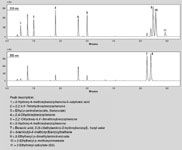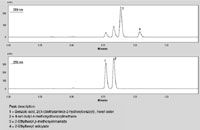Good Day, Sunshine — High Speed Analysis of UV Absorbers
The Application Notebook
Use of UV filters in cosmetic formulations is regulated by international authorities. The concentration of these compounds in cosmetic products is controlled constantly. The following methods describe a simple, fast and ultra fast LC method for determination of UV absorbers. HALO C18* was used as column.
Introduction
Sun protection cosmetics contain UVA/UVB wide filters. They absorb significant parts of the UV radiation and protect the skin from a high dose. UVA filter protects from long-term skin damage, whereas UVB filters protect against sunburn. The UV absorbers are dissolved in the sun protection cosmetics. After applying, they form an invisible layer on the skin and in the upper parts of the skin. Although UV filters have a protective function, their levels in cosmetic products are regulated by the European Union and are controlled by scientific consultants of the EU and by international authorities.

Figure 1: Chromatogram of the separation of 11 UV absorbers.
For determination of 11 ultraviolet absorbing compounds a fast and an ultra fast method were developed using HALO C18 columns. For detection a UV detector in dual channel mode was used. Peak identification was performed in either one or the other channel.

Figure 2
Standard preparation
Standards were prepared in a concentration of 100 mg/L dissolved in methanol.
Method description
For the fast method (runtime 7 minutes) a binary gradient elution was used.
Analytical conditions (fast method)
Column: HALO C18 (150 mm × 2.1 mm i.d.)
Mobile phase:
A) 0.085% phosphoric acid in water
B) Acetonitrile
Time programme: B conc. 30% (0 min) → 70% (3.5 min) → 75% (7 min)
Flow rate: 0.8 mL/min
Temperature: 60 °C
Detection: Absorbance at 310 nm and 355 nm with semi-micro flow cell
Sample volume: 2 µL
For ultra fast analysis a isocratic method was used (runtime < 1.5 minutes).
Analytical conditions (ultra fast method)
Column: HALO C18 (150 mm × 2.1 mm i.d.)
Mobile phase:
A) 0.085% phosphoric acid in water
B) acetonitrile
A/B 15/85 (vol./vol.)
Flow rate: 0.8 mL/min
Temperature: 60 °C
Detection: Absorbance at 310 nm and 355 nm with semi-micro flow cell
Sample volume: 2 µL
The method presented is sufficient to detect typical UV absorbing compounds in cosmetic products.
*HALO is a registered trademark of Advanced Materials Technology Inc.

Shimadzu Europa GmbH
Albert Hahn Str. 6–10, D-47269 Duisburg, Germany
tel. +49 203 7687 0 fax +49 203 76 66 25
E-mail: shimadzu@shimadzu.eu
Website: www.shimadzu.eu

Automated Sample Preparation (ISO 20122) for MOSH/MOAH in Seasoning Oils
May 6th 2025This work presents an Automated Sample Preparation procedure for MOSH/MOAH analysis of Seasoning Oils. We compare results from a manual epoxidation procedure compliant with DIN 16995 with results based on fully automated sample preparation (epoxidation and saponification) compliant with ISO 20122. In both cases, online clean-up via activated aluminum oxide (AlOx) are used to remove interfering n-alkanes from the MOSH fraction during the HPLC run. Automated data evaluation using a dedicated software (GERSTEL ChroMOH) is presented.
Free Poster: NDSRI Risk Assessment and Trace-Level Analysis of N-Nitrosamines
April 25th 2025With increasing concern over genotoxic nitrosamine contaminants, regulatory bodies like the FDA and EMA have introduced strict guidelines following several high-profile drug recalls. This poster showcases a case study where LGC and Waters developed a UPLC/MS/MS method for quantifying trace levels of N-nitroso-sertraline in sertraline using Waters mass spectrometry and LGC reference standards.

.png&w=3840&q=75)

.png&w=3840&q=75)



.png&w=3840&q=75)



.png&w=3840&q=75)













